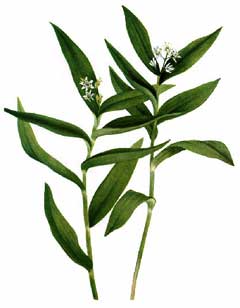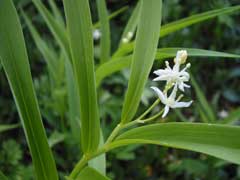 |
|
http://commons.wikimedia.org/wiki/File:Smilacina_stellata-2,_by_Mary_Vaux_Walcott.jpg |
 |
| http://fr.wikipedia.org/wiki/Utilisateur:Bouba |
Translate this page:
Summary
Smilacina stellata (L.) Desf. is a synonym of Maianthemum stellatum (L.) Link
Physical Characteristics

 Smilacina stellata is a PERENNIAL growing to 0.6 m (2ft) by 0.6 m (2ft in).
Smilacina stellata is a PERENNIAL growing to 0.6 m (2ft) by 0.6 m (2ft in).
See above for USDA hardiness. It is hardy to UK zone 3. It is in flower from May to June, and the seeds ripen from August to September. The species is hermaphrodite (has both male and female organs) and is pollinated by Insects.
Suitable for: light (sandy), medium (loamy) and heavy (clay) soils and prefers well-drained soil. Suitable pH: mildly acid and neutral soils. It can grow in full shade (deep woodland) or semi-shade (light woodland). It prefers moist soil.
UK Hardiness Map
US Hardiness Map
Synonyms
Maianthemum stellatum, Smilacena stellata
Plant Habitats
Edible Uses
Edible Parts: Shoots
Edible Uses:
Fruit - raw or cooked[105, 161]. The fruit is about the size of a pea and is produced on the plant in small terminal clusters of about 2 - 8 berries[256]. It has a nice bitter-sweet flavour that is somewhat reminiscent of treacle[85, K]. The fruit is a good source of vitamin C, it has been used to prevent scurvy[213]. The fruit is said to be laxative in large quantities when eaten raw, especially if you are not used to eating it, though thorough cooking removes this laxative effect[K]. Young leaves - raw or cooked. The young shoots, as they emerge in spring, can be used as an asparagus substitute[85]. The young shoots and leaves are cooked and used as greens[212]. Root - cooked. It should be soaked in alkaline water first to get rid of a disagreeable taste[85, 213]. It can be eaten like potatoes[213].
References More on Edible Uses
Medicinal Uses
Plants For A Future can not take any responsibility for any adverse effects from the use of plants. Always seek advice from a professional before using a plant medicinally.
Vitamin C
Star-flowered lily of the valley was employed medicinally by several native North American Indian tribes who used it to treat a variety of complaints[257]. It is little, if at all, used in modern herbalism. A tea made from the roots is drunk to regulate menstrual disorders[213]. A decoction of the leaves is taken 2 - 3 times a day in the treatment of rheumatism and colds[257]. Half a cup of leaf tea drunk daily for a week by a woman is said to prevent conception[213, 257]. The root is analgesic, antiseptic, haemostatic, ophthalmic, stomachic and vulnerary[257]. An infusion has been used in the treatment of stomach complaints, internal pains and to regulate menstrual disorders[257]. The dried powdered root has been used in treating wounds and bleeding[213, 257]. The crushed root has been used as a poultice on sprains, boils, swellings and limbs affected by rheumatism[257]. The pulped root has been used as ear drops to treat ear aches[257]. An infusion of the roots has been used as a wash for inflamed eyes[257].
References More on Medicinal Uses
The Bookshop: Edible Plant Books
Our Latest books on Perennial Plants For Food Forests and Permaculture Gardens in paperback or digital formats.

Edible Tropical Plants
Food Forest Plants for Hotter Conditions: 250+ Plants For Tropical Food Forests & Permaculture Gardens.
More

Edible Temperate Plants
Plants for Your Food Forest: 500 Plants for Temperate Food Forests & Permaculture Gardens.
More

More Books
PFAF have eight books available in paperback and digital formats. Browse the shop for more information.
Shop Now
Other Uses
Plants can be grown as a ground cover when planted about 60cm apart each way[208]. An inferior cover to S. racemosa[208].
Special Uses
References More on Other Uses
Cultivation details
Requires a deep fertile humus rich moisture retentive soil, neutral to slightly acid, that does not dry out in the growing season, and a shady position[200]. Does well in a woodland garden[200]. Plants have a creeping rhizome and can form extensive patches[187]. Fruits well in a shady woodland position at Kew[K]. Hardy to about -25°c[187]. Plants are slow to establish but then can become invasive[208]. The flowers are powerfully scented[245].
References Carbon Farming Information and Carbon Sequestration Information
Temperature Converter
Type a value in the Celsius field to convert the value to Fahrenheit:
Fahrenheit:
The PFAF Bookshop
Plants For A Future have a number of books available in paperback and digital form. Book titles include Edible Plants, Edible Perennials, Edible Trees,Edible Shrubs, Woodland Gardening, and Temperate Food Forest Plants. Our new book is Food Forest Plants For Hotter Conditions (Tropical and Sub-Tropical).
Shop Now
Plant Propagation
Seed - best sown as soon as it is ripe in a cold frame. The seed can be very slow to germinate, often taking 18 months. Stored seed should be sown in a cold frame as soon as possible, it may take 2 years or longer to germinate. Grow the seedlings on in a shady part of a greenhouse for their first year without pricking them out, giving them liquid or foliar feeds as required to ensure that they do not become nutrient deficient. Divide the young plants up into individual pots in the autumn when they are dormant, and grow them on for at least another year in a shady part of the greenhouse. When the plants have reached a sufficient size, plant them out in the autumn whilst they are dormant. Division in spring or early autumn. Very easy, larger divisions can be planted out direct into their permanent positions. We have found it best to pot up the smaller divisions and grow them on in a lightly shaded position in a cold frame, planting them out once they are well established in the summer.
Other Names
If available other names are mentioned here
Native Range
NORTHERN AMERICA: Canada (Northwest Territories, Yukon, Québec, Nova Scotia, Ontario, Prince Edward Island, New Brunswick, Newfoundland and Labrador, Saskatchewan, Alberta, Manitoba, British Columbia), United States (Alaska, Indiana, Maine, Massachusetts, Michigan, New Hampshire, New Jersey, New York, Ohio, Pennsylvania, Rhode Island, Vermont, West Virginia, Connecticut, Illinois, Iowa, Kansas, Minnesota, Missouri, Nebraska, North Dakota, Oklahoma, South Dakota, Wisconsin, Colorado, Idaho, Montana, Oregon, Washington, Wyoming, Delaware, District of Columbia, Kentucky, Maryland, Virginia, Tennessee, New Mexico, Arizona, California, Nevada, Utah), Mexico (Coahuila de Zaragoza, Nuevo León)
Weed Potential
Right plant wrong place. We are currently updating this section.
Please note that a plant may be invasive in one area but may not in your area so it's worth checking.
Conservation Status
IUCN Red List of Threatened Plants Status :

Growth: S = slow M = medium F = fast. Soil: L = light (sandy) M = medium H = heavy (clay). pH: A = acid N = neutral B = basic (alkaline). Shade: F = full shade S = semi-shade N = no shade. Moisture: D = dry M = Moist We = wet Wa = water.
Now available:
Food Forest Plants for Mediterranean Conditions
350+ Perennial Plants For Mediterranean and Drier Food Forests and Permaculture Gardens.
[Paperback and eBook]
This is the third in Plants For A Future's series of plant guides for food forests tailored to
specific climate zones. Following volumes on temperate and tropical ecosystems, this book focuses
on species suited to Mediterranean conditions—regions with hot, dry summers and cool, wet winters,
often facing the added challenge of climate change.
Read More
Expert comment
Author
(L.)Desf.
Botanical References
43200270
Links / References
For a list of references used on this page please go here
Readers comment
© 2010, Plants For A Future. Plants For A Future is a charitable company limited by guarantee, registered in England and Wales. Charity No. 1057719, Company No. 3204567.